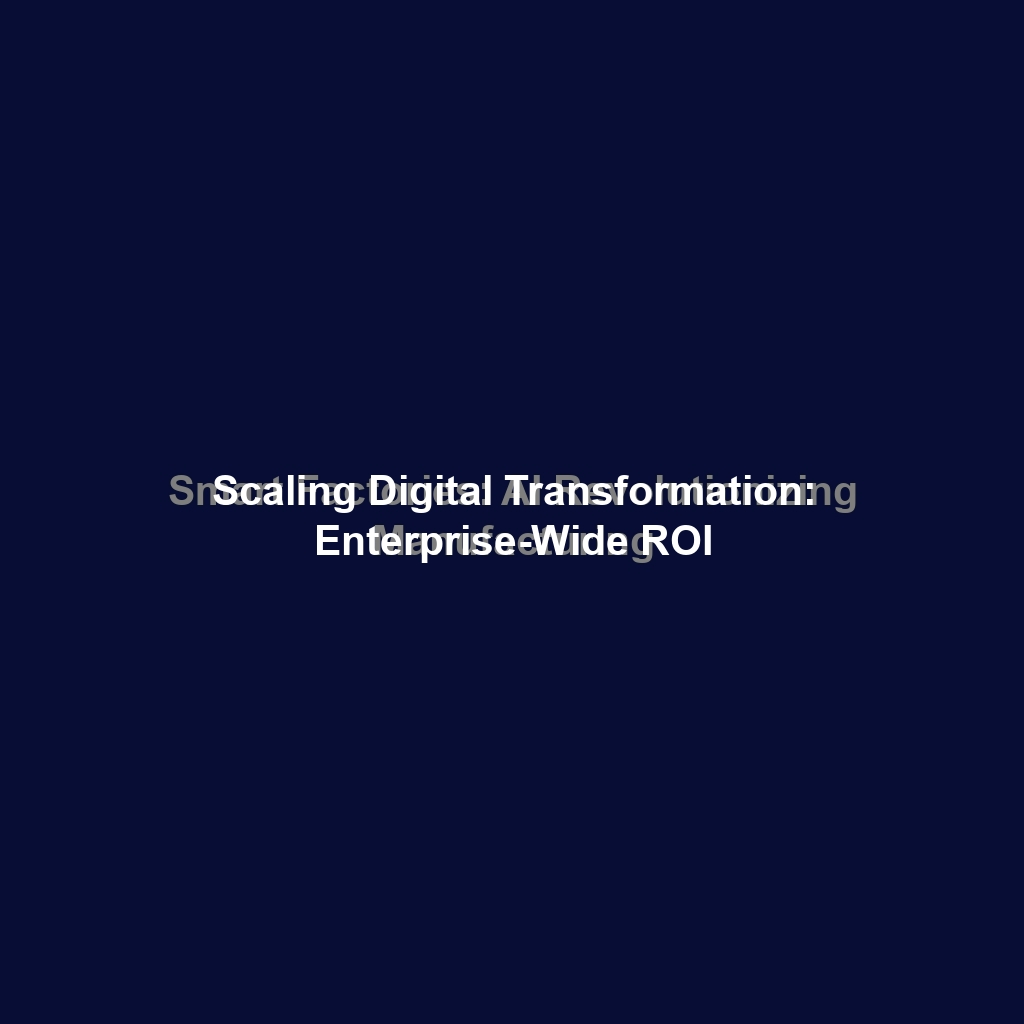In today’s volatile business environment, resilience is no longer a “nice-to-have”; it’s a necessity. Market disruptions, from economic downturns to technological shifts and global pandemics, can cripple even the most established organizations. To navigate these uncertainties, businesses need a proactive approach to planning. That’s where scenario planning comes in. This article outlines how to leverage scenario planning as a tool for anticipating and preparing for various potential market disruptions, ultimately building a more robust and resilient business model.
What is Scenario Planning?
Scenario planning is a structured process for envisioning multiple plausible futures. It moves beyond traditional forecasting, which often relies on extrapolating past trends, and instead explores a range of possible outcomes based on key uncertainties. This approach enables businesses to develop strategic plans that are adaptable and resilient, regardless of which future unfolds.
Unlike traditional forecasting, which attempts to predict a single, most likely future, scenario planning acknowledges the inherent unpredictability of the market. It’s about preparing for a range of possibilities, not predicting the future.
Key Insight: Scenario planning isn’t about predicting the future; it’s about preparing for multiple plausible futures. It builds resilience into your strategic planning process, allowing you to adapt and thrive in the face of uncertainty.
Why is Scenario Planning Important for Building Resilience?
In volatile markets, relying solely on historical data and current trends can lead to strategic missteps. Scenario planning helps businesses:
- Identify Potential Risks and Opportunities: By exploring different future scenarios, businesses can anticipate potential threats and uncover hidden opportunities that might otherwise be missed.
- Improve Strategic Decision-Making: Scenario planning provides a framework for evaluating strategic options under different conditions, leading to more informed and robust decisions.
- Enhance Organizational Agility: By preparing for a range of possibilities, businesses can develop the flexibility and adaptability needed to respond quickly and effectively to market changes.
- Promote Strategic Alignment: The scenario planning process encourages cross-functional collaboration and a shared understanding of the challenges and opportunities facing the organization, fostering strategic alignment.
- Stress-Test Existing Strategies: Before committing to a strategic direction, scenario planning enables you to assess its viability across a range of potential future scenarios.
For example, consider a retail business. Traditional forecasting might focus on projected sales growth based on past performance. However, scenario planning would explore alternative futures, such as:
- Scenario 1: A resurgence of brick-and-mortar shopping driven by a renewed focus on local experiences.
- Scenario 2: A continued shift towards online shopping, with increased competition from e-commerce giants.
- Scenario 3: A hybrid model where consumers blend online and in-store shopping, demanding seamless omnichannel experiences.
By analyzing these scenarios, the retail business can develop strategies to thrive in any of these futures, such as investing in digital infrastructure, optimizing its physical store footprint, or developing personalized customer experiences.
The Scenario Planning Process: A Step-by-Step Guide
Implementing scenario planning involves a structured process, typically encompassing the following steps:
Step 1: Define the Scope and Objectives
Clearly define the scope of the scenario planning exercise. What specific business challenges or strategic decisions are you trying to address? What is the time horizon you are considering? This clarity is crucial for focusing your efforts and ensuring that the scenarios are relevant to your business.
For instance, a manufacturing company might define the scope as “assessing the impact of automation and artificial intelligence on our workforce over the next 5 years.” The objective might be to develop a strategy for reskilling employees and adapting the organization to a more automated environment.
Step 2: Identify Key Uncertainties
Brainstorm a list of factors that could significantly impact your business but are difficult to predict with certainty. These uncertainties might be related to economic conditions, technological advancements, regulatory changes, competitor actions, or social trends.
Some common categories of uncertainties include:
- Economic: Inflation rates, interest rates, economic growth, consumer spending.
- Technological: Disruptive technologies, adoption rates, cybersecurity threats.
- Political/Regulatory: Trade policies, environmental regulations, data privacy laws.
- Social: Changing demographics, consumer preferences, social movements.
- Competitive: New market entrants, disruptive business models, industry consolidation.
During a recent engagement with a logistics company, we identified the following uncertainties as critical: fuel prices, autonomous vehicle adoption, and government regulations regarding drone delivery. These three uncertainties formed the basis for developing several plausible scenarios.
Step 3: Prioritize Uncertainties
Not all uncertainties are created equal. Prioritize the uncertainties that have the greatest potential impact on your business and are the most unpredictable. A useful tool for this is a 2×2 matrix, plotting uncertainties based on their impact and uncertainty levels. The high-impact, high-uncertainty factors become the focus of your scenario development.
Consider the example of a tourism company. While factors like weather patterns can influence daily operations, they are relatively predictable. A more critical uncertainty might be the impact of future pandemics or geopolitical instability on international travel. These events are both highly impactful and difficult to predict, making them prime candidates for scenario planning.
Step 4: Develop Plausible Scenarios
Based on the prioritized uncertainties, develop a set of 3-4 distinct scenarios that represent different plausible futures. Each scenario should be internally consistent and logically coherent. Avoid creating scenarios that are too similar or too extreme. Aim for a balance of optimistic, pessimistic, and “business-as-usual” possibilities.
Each scenario should tell a story: give it a descriptive name and narrative that brings it to life. This helps stakeholders understand the potential implications and engage with the scenario planning process.
For the logistics company mentioned earlier, we developed the following scenarios:
- Scenario 1: “Autonomous Efficiency”: Fuel prices remain stable, autonomous vehicles are rapidly adopted, and regulations support drone delivery.
- Scenario 2: “Regulatory Roadblock”: Fuel prices increase, autonomous vehicle adoption is slow due to safety concerns, and regulations restrict drone delivery.
- Scenario 3: “Green Revolution”: Fuel prices skyrocket, driving demand for alternative fuels and electric vehicles, autonomous vehicle adoption is moderate, and regulations incentivize sustainable logistics practices.
Key Insight: Scenarios should be plausible, distinct, and internally consistent. They should paint a vivid picture of different potential futures, allowing you to explore a range of strategic responses.
Step 5: Develop Contingency Plans
For each scenario, develop a contingency plan that outlines the actions your business will take to mitigate risks and capitalize on opportunities. These plans should be specific, measurable, achievable, relevant, and time-bound (SMART). Consider the resources required, the potential costs and benefits, and the key performance indicators (KPIs) you will use to track progress.
The contingency plans should address key areas such as:
- Operations: How will you adjust your supply chain, production processes, and distribution channels?
- Marketing and Sales: How will you adapt your marketing messages, pricing strategies, and sales channels?
- Finance: How will you manage your cash flow, investments, and debt?
- Human Resources: How will you reskill employees, adjust staffing levels, and adapt your organizational structure?
For the logistics company, the contingency plan for the “Regulatory Roadblock” scenario included:
- Investing in fuel-efficient vehicles and driver training programs to mitigate the impact of higher fuel prices.
- Lobbying for more favorable regulations regarding autonomous vehicles and drone delivery.
- Exploring partnerships with companies that have expertise in navigating complex regulatory environments.
Step 6: Monitor and Adapt
Scenario planning is not a one-time exercise. It’s an ongoing process that requires continuous monitoring and adaptation. Regularly track key indicators to assess which scenario is unfolding and adjust your contingency plans accordingly. Be prepared to revise your scenarios and contingency plans as new information becomes available.
Establish a system for monitoring the key uncertainties and tracking the performance of your contingency plans. This might involve setting up dashboards, conducting regular reviews, and assigning responsibility for monitoring specific indicators to different team members.
A software company, for example, might monitor the adoption rates of different cloud platforms, the emergence of new cybersecurity threats, and changes in data privacy regulations to assess which scenario is unfolding and adjust its product development and marketing strategies accordingly.
Real-World Examples of Scenario Planning in Action
Many successful organizations have used scenario planning to navigate volatile markets and build resilient business models. Here are a few examples:
- Shell: Shell has been a pioneer in scenario planning since the 1970s. They have used it to anticipate major shifts in the energy market, such as the oil crises of the 1970s and the rise of renewable energy. Their scenario planning process has helped them make strategic investments and adapt to changing market conditions. Learn more about Shell’s scenarios.
- Google: Google uses scenario planning to explore the future of technology and its impact on society. They have developed scenarios on topics such as artificial intelligence, the internet of things, and the future of work. This helps them anticipate emerging trends and develop innovative products and services.
- Governments: Governments around the world use scenario planning to address complex challenges such as climate change, economic instability, and national security. They develop scenarios to explore different policy options and assess their potential impacts. The UK Government Office for Science is a notable example. Learn more about the UK Government Office for Science.
During my time consulting with a regional airline, we used scenario planning to address the uncertainty surrounding fuel prices, environmental regulations, and the emergence of low-cost carriers. We developed scenarios ranging from “Sustainable Skies” (high fuel prices, strict environmental regulations) to “Price Wars” (low fuel prices, aggressive competition from low-cost carriers). This enabled the airline to develop contingency plans for fuel hedging, fleet modernization, and route optimization, ultimately helping them maintain profitability in a challenging market.
Implementing Scenario Planning within Your Organization
Implementing scenario planning successfully requires a commitment from senior management, a cross-functional team, and a willingness to challenge conventional thinking. Here are some steps to get started:
- Secure Leadership Buy-In: Explain the benefits of scenario planning and demonstrate how it can help the organization achieve its strategic goals.
- Form a Cross-Functional Team: Include representatives from different departments, such as marketing, finance, operations, and human resources, to ensure a diverse range of perspectives.
- Provide Training: Train team members on the principles and techniques of scenario planning.
- Use Facilitation: Engage a facilitator to guide the scenario planning process and ensure that it remains objective and focused.
- Communicate the Results: Share the scenarios and contingency plans with key stakeholders and ensure that they are integrated into the organization’s strategic planning process.
- Regularly Review and Update: Make scenario planning an ongoing process, regularly reviewing and updating the scenarios and contingency plans as new information becomes available.
One of the biggest challenges in implementing scenario planning is overcoming resistance to change. Some people may be skeptical of the process or uncomfortable with the uncertainty it involves. It’s important to address these concerns by clearly communicating the benefits of scenario planning and involving stakeholders in the process.
Overcoming Common Challenges in Scenario Planning
While scenario planning is a powerful tool, it’s not without its challenges. Here are some common pitfalls to avoid:
- Confirmation Bias: Be aware of the tendency to favor information that confirms existing beliefs. Encourage the team to challenge assumptions and consider alternative perspectives.
- Groupthink: Avoid situations where team members conform to the opinions of the majority. Encourage open discussion and dissenting viewpoints.
- Analysis Paralysis: Don’t get bogged down in too much detail. Focus on the key uncertainties and develop scenarios that are relevant to the business’s strategic goals.
- Ignoring the “Black Swans”: While scenarios should be plausible, don’t completely rule out low-probability, high-impact events. Consider the potential consequences of these “black swan” events and develop contingency plans to mitigate their impact. Nassim Nicholas Taleb’s work on Black Swan events is highly relevant (Taleb, 2007).
In a previous consulting project, a client was initially resistant to considering a “worst-case” scenario involving a significant economic recession. They believed it was too pessimistic and unlikely. However, by facilitating a constructive dialogue and presenting evidence of past economic downturns, we were able to convince them to include a recession scenario in their planning. This ultimately helped them develop a more robust strategy and avoid significant losses when the recession eventually occurred.
Tools and Technologies for Scenario Planning
Several tools and technologies can support the scenario planning process, including:
- Spreadsheet Software: Excel or Google Sheets can be used to create models and analyze data for each scenario.
- Mind Mapping Software: MindManager or XMind can be used to brainstorm ideas and organize information.
- Scenario Planning Software: Dedicated scenario planning software, such as StratX Simulations or Gnowsis, can provide a more structured and collaborative environment.
- Data Visualization Tools: Tableau or Power BI can be used to create dashboards and visualize key indicators.
The choice of tools and technologies will depend on the size and complexity of the scenario planning exercise, as well as the organization’s budget and resources. However, the most important factor is to choose tools that are easy to use and that support collaboration and communication.
Conclusion: Building a Resilient Future with Scenario Planning
In an increasingly volatile and uncertain world, scenario planning is an essential tool for building resilient business models. By anticipating potential market disruptions, developing plausible scenarios, and creating contingency plans, businesses can prepare for the unexpected and thrive in the face of adversity. Embrace scenario planning as an ongoing process, foster cross-functional collaboration, and adapt your strategies as new information becomes available. By doing so, you can navigate the challenges of today and build a more resilient future for your organization.
Are you ready to build a more resilient business? Contact us today to learn how we can help you implement scenario planning and prepare for the future.
This article was optimized and published by Content Hurricane.


